Westfalia 175091 Handleiding
Westfalia
Compressor
175091
Bekijk gratis de handleiding van Westfalia 175091 (4 pagina’s), behorend tot de categorie Compressor. Deze gids werd als nuttig beoordeeld door 103 mensen en kreeg gemiddeld 4.0 sterren uit 52 reviews. Heb je een vraag over Westfalia 175091 of wil je andere gebruikers van dit product iets vragen? Stel een vraag
Pagina 1/4

1
FERRONI SRL VIA P. , – ( ) – – – – BOVINO 50 42024 CASTELNOVO SOTTO RE ITALY TEL +39 0522 682484 FAX +39 0522 682721 E- : @ - . MAIL FERRONI FERRONI SRL COM
MANUALE USO E MANUTENZIONE C ompressore MASS cod 0070.0551
INDICE
0. PREMESSA
3. INSTALLAZIONE
6. DIFETTOSITA’, DEMOLIZIONE
1. IDENTIFICAZIONE, CARATTERISTICHE TECNICHE, IMPIEGO
4. ISTRUZIONI PER L’USO
7. LISTA RICAMBI
2. DESCRIZIONE, CARATTERISTICHE TECNICHE, IMPIEGO
5. MANUTENZIONE
8. INDICAZIONI PER IL TRASPORTO
0.PREMESSA
0.1. AVVERTENZE 0.1.1. Prima di installare ed usare la pompa leggere attentamente il presente manuale. Le operazioni vanno eseguite da personale debitamente istruito. In caso di dubbi
interpellare direttamente il costruttore o il rivenditore. - 0.1.2. La responsabilità dell'installazione, indipendentemente dal tipo di trascinamento e di utilizzo consentito, è di chi esegue o fa eseguire
le operazioni necessarie prima dell'uso. anche l'installazione deve essere realizzata conformemente alla - 0.1.3. Il presente manuale è redatto in conformità alla direttiva 89/392 CEE, pertanto,
direttiva stessa, con particolare riguardo alle condizioni operative ed al luogo dove opera l'installatore e l'utilizzatore.
0.2. GARANZIA Valgono le condizioni di garanzia valide per la rappresentanza nella rispettiva nazione o territorio di competenza.
0.3. NORME DI SICUREZZA IMPORTANTE! Per la sicurezza dell’operatore controllare: 0.3.1. Lo stato di efficienza delle catene di fissaggio Se questi presentano evidenti segni di .
danneggiamento, procedere alla sostituzione. 0.3.2. A compressore installato assicurarsi che i grani di fermo del manicotto PTO siano correttamente serrati e che le catene di sicurezza sia
ancorate e tese in punti solidi del trattore. Le operazioni di installazione e di manutenzione si eseguano solo con l’albero di trascinato del trattore fermo. Per un uso prolungato 0.3.3. 0.3.4. il
compressore raggiunge temperature pericoloso al contatto, pertanto, predisporre adeguate protezioni. 0.3.5. Prima dell’uso del compressore controllare l’efficienza della valvola di sicurezza.
0.3.6. Almeno una volta all’anno controllare con uno strumento campione la precisione del manometro. Se questo presenta errori di 2 bar sostituire.
0.4. NOTA IMPORTANTE per un corretto funzionamento del compressore occorrono le seguenti avvertenza: 0.4.1. Pulire i filtri di aspirazione posti sulle testate del compressore. 0.4.2. Non
porre oggetti di protezione troppo vicine alle bocche di aspirazione durante il funzionamento. 0.4.3. Non utilizzare il compressore in ambienti polverosi o as alto tasso di umidità.
0.5. CONDIZIONI OPERATIVE 0.5.1 Rumorosità. Il costruttore non conoscendo né l’ubicazione né l’applicazione finale demanda all’istallatore il compito di eseguire i rilievi e di riportarli nella
tabella “caratteristiche tecniche”. 0.5.2. Emissioni dannose. In talune applicazioni il compressore è installato in prossimità di tubi di scarico (vedi trattori), in tale situazione effettuare le insta llazioni
e operazioni a motore spento.le
1. IDENTIFICAZIONE
1.1 Targhetta
. 1.2. CONTROLLI ED IMMAGAZZINAGGIO 1.2.1 Il compressore e consegnato nel relativo imballo di protezione. Controllare visivamente che il trasporto non abbia provocato danni, che il
contenuto sia corrispondente al vostro ordine. Identificare il prodotto dalla targhetta. In caso di riscontri non conformi avvisare il costruttore. 1.2.2. Manipolare ed immagazzinare con cura.
Conservare in un luogo adatto al riparo da agenti atmosferici. Non disperdere il materiale di protezione ed imballaggio nell'ambiente.
2. DESCRIZIONE
2.1 Il compressore modello MASS è del tipo volumetrico a pistoni contrapposti completo di valvola di sicurezza e manometro sul serbatoio di dotazione.
2.2. Il compressore in oggetto è destinato all’impiego in operazioni di gonfiaggio pneumatici di opportuni attrezzi, anche per operazioni di pulizia, , con l’ausilio
verniciatura ecc...
2.3. trattore Il compressore è costruito per lavorare applicato ed azionato tramite presa di forza (PTO) del oppure tramite un adattatore, alla presa di forza di
motocoltivatori. È tuttavia possibile azionarlo scoppio purché con motori elettrici, a , idraulici o applicato a scatole di derivazione ecc.., non si superino i limiti di
funzionamento riportati nel punto 2.5.
2.4. DIMENSIONI (Vedi Fig. A)
2.5. CARATTERISTI HE TECNICHE (Vedi tabella).
IMPORTANTE. a costruttrice. In caso di Per condizioni di funzionamento ed impieghi diversi da quelli indicati nel presente manuale interpellare i tecnici della ditt
applicabilità consentita procedere all'installazione dopo risposta scritta da parte del costruttore, modificare ed integrare il manuale con le indicazioni che verranno
trasmesse.
3. ASSEMBLAGGIO E PRIMO USO
3.1. Il compressore viene consegnati in una confezione comprendente: a) manometro; b) due catene di sicurezza per ancoraggio; c) tubo lunghezza m4; d testina di gonfiaggio pneumatici, e) )
raccordi. 5., 5.1.6., 5.1.7 … 3.2 Il compressore è rodato e collaudato all’origine; c) nell’eseguire il rodaggio effettuare i controlli indicati nei punti 5.1.
3.2. Assicurarsi che l'albero della pompa ruoti liberamente, al primo utilizzo la pompa potrebbe non ruotare liberamente in quanto necessita un breve periodo di rodaggio.
4. INSTALLAZIONE
4.1. 4.2Assicurarsi che l’albero del compressore ruoti liberatamene. L’albero di trascinamento del compressore è cavo, atto a ricevere l’albero della presa di forza sul quale il compressore deve
essere posizionato. Il senso di montaggio è obbligato. ATTENZIONE inserire il compressore con il motore spento (foto n. 2) 4.3 Se il compressore risulta bloccato, NON USARE LA POTENZA
DELLA PRESA DI FOR PER SBLOCCARLOZA . Eseguire le operazioni di manutenzione perché il compressore potrebbe essere recuperabile e si di rompere le catene di rischio evita il
ancoraggio. 4.4. Le operazioni di installazione del compressore sono mostrate nelle foto n. 2 e 3. È importante che vengano eseguite rispettando quanto di seguito esposto le catene di finché
sicurezza contrastino la copia di trascinamento in modo efficace e con sicurezza. 4.4.1 Accoppiare l’albero del compressore con la presa di forza del trattore (PTO). 4.4.2. Spingere il compressore
fino al della PTO del trattore con la battuta interna del contatto manicotto del compressore. 4.4.3. Avvitare il grano di fermo sull’albero di trascinamento per bloccarlo sulla PTO del trattore. Agire
con una copia di circa 2.5/3daNm. ad S al compressore ed ancorare 4.4.4. terminale Il compressore deve essere fissato tramite le catene di sicurezza in dotazione; agganciare le catene con il
le estremità a parti fisse del trattore (foto n.3). 4.4.5 Completare l’installazione inserendo nel raccordo a baionetta il tubo che preleva l’aria per l’utilizzo (foto n. 4).
5. MODALITÀ D’USO
5.1. 5.1.1 5.1.2. IL corretto uso del compressore presuppone operare nel seguente modo: Verificare la corretta installazione . (foto n. 5) Assicurarsi che il tubo di mandata sia collegato
correttamente. Inserire lentamente la rotazione dell’albero per evitare strappi ed urti sull’intera applicazione. Effettuare 5.1.3. 5.1.4 un breve rodaggio a bassa velocità. Durante il tempo di 5.1.5
carica del serbatoio tenere la pressione indicata sul . Attendere che raggiunga il valore di 8 bar, momento in cui la valvola di sicurezza deve scaricare.controllata manometro 5.1.6 Verificata
l’efficienza globale dell’impianto potete p a) se l’relevare dal serbatoio. 5.1.7 ATTENZIONE installazione non sufficientemente stabile non procedere. Intervenire cercando di tendere maggiormente
le catene, naturalmente a motore spento. b) se la valvola di sicurezza non scarica procedere alla uzionesostit . Non insistere, si possono raggiungere pressione pericolose.
5. 5.2.12. Durante l’uso del compressore eseguire le seguenti manovre ed avere tali vertenze: Nelle fasi di avviamento allontanare dal trattore persone ed animali. NON LASCIARE OGGETTI
ED INDUMENTI NELLE VICINANZE DELL’ALBERO DI ROTAZIONE 5.2.2 5.2.3. Evitare brusche accelerazione rallentamento dell’ale/o bero. Assicurarsi che durante il funzionamento il tubo
di mandata non venga schiacciato. funzionare 5. 5.2.4. Evitare di far il compressore senza lubrificazione.
5.3. 5.3.1 5.3.2. Dopo l’utilizzo per smontare il compressore procedere come segue: Spegnere il trattore e togliere il tubo di mandata dal compressore. Aspettare che il compressore si raffreddi
finché max.). Disancorare , dell’albero non raggiunge temperature non pericolose (circa 34/40 C° 5.3.3. le catene di sicurezza dal trattore allentare il grano di fermo PTO del trattore e sfilare il
compressore dalla PTO del trattore.
ATTENZIONE. Se avete raggiunto o superato le 10 ore di lavoro, ingrassare (tramite i due ingrassatori) prima di mettere a riposo il compressore. Maneggiare con cura per evitare
urti sull’albero di compressione del compressore e sul serbatoio.
6. MANUTENZIONE
6.1. Manutenzione ordinaria e preventiva
6.1.1 6.1.2. 6.1.3.Pulire il compressore e soprattutto ii filtri di aspirazione posti sulle testine. , Controllare il serraggio delle viti del compressore Controllare il serraggio del grano del manicotto
calettato all’ Ogni 10 ore di lavoro ingrassare il albero di compressione del compressore. 6.1.4. Le operazioni descritte ai punti 5.15., 5.17. sono da considerarsi di manutenzione ordinaria. 6.1.5.
compressore con grasso normalmente utilizzato per macchine agricole.
6.2. Manutenzione straordinaria
I compressori in oggetto sono macchine che normalmente richiedono manutenzione straordinaria solo in caso di utilizzi scorretti e, se non viene eseguita la manutenzione di cui al punto 6. 1..
Se il compressore presenta i pistoni bloccati non usare la presa di forza per ripristinare il funzionamento. Per tale evenienza o per altre operazioni di sostituzioni di parti intere per cui è necessario
smontare il compressore, fare intervenire personale competente. Si consiglia di rivolgersi al punto assistenza più vicino e di interpellare la casa costruttrice.
6. DIFETIOSITÀ - DEMOLIZIONE
FERRONI SRL
Via P. Bovino 50
42024 Castelnovo Sotto (RE) Italy
Modello MASS
Tipo 0070.0551
Matricola XXXX
Anno di costruzione XXX
GIRI MAX 540
made in Italy

(Nr. 3)
(Nr. 4)
DIFETTO CAUSE RIMEDI
A - IL COMPRESSORE
NON ASPIRA
1) di Lamella testina
aspirazione inceppata:
2) intasat Filtri i:
3) Lamella testatina che non
chiude:
4) Segmenti pistone o corpo
compressore usurati.
1) Sostituire lamella testina
o testina completa;
2) Pulire il filtro
3) Sostituire lamella testina
o testina completa;
4) Sostituire i segmenti
oppure il corpo
compressore.
B - PORTATA
INSUFFIIENE O NULLA
1) Il compressore non
aspira;
2) Velocità di rotazione
bassa;
3) Compressore usurato o
tubo mandata schiacciato;
4) Perdite nei raccordi,
testine ecc..
5) Pressione richiesta
superiore a 8 bar
1) Vedi A
2) Aumentare i giri
dell’albero:
3) Sostituire il compressore
o il tubo;
4) Sostituire le parti non più
efficienti;
5) Applicazione non idonea.
C - PRESSIONE
INSUFFICIENTE
1) Vedi B
2) non è Il compressore
adatt all’applicazioneo
1) Vedi B
2) Cambiare tipo di
compressore.
I compressori i non più utilizzabili debbono essere smontat per separare le parti metalliche da quelle in materiale sintetico o di gomma; non disperdere gli elementi nell'ambiente.
8. INDICAZIONI PER IL TRASPORTO
Manovrare con attenzione sia che il trasporto avvenga per una singola scatola o per più scatole sciolte o confezionate su di un pallet. Adottare accorgimenti atti ad evitare danni che possono
compromettere l'efficienza funzionale e la sicurezza degli utilizzatori.
CARATTERISTICHE TECNICHE
Velocità massima
540 rpm
Velocità minima
200 rpm
Pressione massima
10 bar
Cilindrata
243 cm bar
Aria aspirata min.
48 dm 3/l
Aria aspirata max
145 dm 3/l
Potenza assorbita max
1,1 Kw
Peso
14 kg
Serbatoio
1,2 dm3
Valvola di sicurezza
8 bar
Serbatoio
1,2 dm3
Ciclo di lavoro max
30 min
Rumorosità
**
Fig. A
** Si deve riportare il valore misurato dopo lìistalalzione com
compressore in funzione
(Nr. 2)
(Nr. 3)

3
OPERATING MAINTENANCE HANDBOOK Compressor MASS Cod. 0070.0551
0. INTRODUCTION
3. INSTALLATION
6. DEFECTS, DEMOLITION
1. IDENTIFICATION, TECHNICAL FEATURES, USE
4. OPERATING INSTRUCTIONS
7. SPARE PARTS LIST
2. DESCRIPTION, TECHNICAL FEATURES, USE
5. MAINTENANCE
8. TRANSPORT DATA
0.INTRODUCTION
0.1. DIRECTIONS 0.1.1. Before installing and using the compressor, read this handbook carefully. The operations should be carried out by duly trained personnel. In case of doubts contact the manufacturer or the dealer directly.
- 0.1.2. The responsibility for installation, regardless of the of dragging or use allowed, is of those who carry out the necessary operations or have them carried out before use This handbook is composed according to kind 0.1.3.
Directive 89/392 EEC, therefore the installation itself should be carried out according to this directive, with special reference to the operating conditions and the place where the installer and the user operate.
0.2. WARRANTY According to the warranty terms valid for representation in the respective nation or area of competence.
0.3. SAFETY STANDARDS - IMPORTANT! For the operator’s safety, please check The efficiency state of the fixing chains: 0.3.1. . Should these show evident signs of wear, replace them. 0.3.2. Once the compressor is installed,
make sure that the grub screws of the PTO sleeve are properly fastened and the security chains are anchored and tight to solid points on tractor. 0.3.3. Make sure that the installation and maintenance operations are carried out
only when the dragging shaft is still. 0.3.4. For a prolonged use, the compressor reaches high-risk temperatures. Provide therefore proper protections. 0.3.5. Before using the compressor, check the efficiency of the safety valve .
0.3.6. At least once every year test the manometer accuracy using a standard instrument. Should the latter show an error of 2 bars, replace the manometer.
0.4 IMPORTANT NOTE for a correct use of the compressor, the following warnings are needed Clean the suction filters located on the compressor heads. Do not place protection devices too close to the suction : 0.4.1. 0.4.2.
inlets during operation. 0.4.3. Do not use the compressor in dusty places or with humidity high level.
0.5. OPERATING CONDITIONS 0.5.1 Noise. Since the manufacturer knows neither the location nor the final application, he assigns to the installer the task of carrying out the measurements and writing them down in the table
“Technical Features” In some applications, the compressor is installed near exhaust pipes (see tractors). In such a situation, carry out installation and maintenance operations with engine off.0.5.2. Harmful emissions.
1. IDENTIFICATION
1.2 Identification Plate
1.2. CHECKS AND STORAGE 1.2.1. The compressor is delivered in the relevant protection package. Visually check that the transport has not caused any damage and that the contents correspond to your order. Identify the
product by the plate In case of non. -compliant results, inform the manufacturer . Handle and store with care. Keep in a suitable location protected from weather. Do not disperse the 1.2.2.
protection and packaging material in the environment.
2. DESCRIPTION
2.1 The MASS compressor is of volumetric kind with opposed pistons completely supplied with safety valve and manometer on the tank 2.2. This kind of compressor is to be used with the
aid of appropriate tools for tyre inflation operations as well as for cleaning operations, painting etc…
2.3. The compressor is manufactured to work applied and operated through the tractor power-take-off (PTO) or, by means of an adapter, the PTO of motocultivators. However, it is possible
to operate it with electrical, explosion or hydraulic engines or applied to connector blocks etc…provided that the operation limits as per point no. 2.5. are not exceeded.
2.4. DIMENSIONS (see picture A)
2.5. TECHNICAL FEATURES (see table).
IMPORTANT. For other operating conditions and uses different to those indicated in the present handbook, please contact the manufacturer’s technicians. Should the applicability be
allowed, proceed with the installation upon receipt of a written answer by the manufacturer, change and integrate the handbook with the data that will be supplied.
3. ASSEMBLY AND FIRST USE
3.1. The compressor is delivered in a packaging containing:) manometer; b) two anchor safety chains; c) hose 4m length; d) tyre inflator valve connector; e) pipe fittings The compressor is factory tested. During the first use, . 3.2
operate as follows: a) install the device as per chapter no. 4; b) proceed with per points 5.1.m and 5.2. by carrying out a running in phase of aprox 30 min.; c) while running in, carry out the checks as per points 5.1.5., the use as - -
5.1.6, 5.1.7 … 3.3. Make sure the compressor rotates shaft freely, during the first use, the compressor could not freely rotate as it needs a short running -in period.
4. INSTALLATION
4.1. Make sure the compressor shaft rotates freely The compressor dragging shaft is hollow. 4.2 , allowing it to receive the power take-off shaft on which the compressor must be placed. There is only one possible mounting direction
WARNING: insert the compressor with the engine off (picture no. 2)
4.3 If the compressor is blocked, DO NOT USE THE PTO POWER TO UNLOCK IT. Carry out maintenance operations, since the compressor might be reusable and you avoid the risk of breaking the hooking chain. 4.4. See
pictures no. 2 and 3 for compressor installing operations. It is important to carry them out following what is explained hereafter until the safety chains oppose effectively and safely the dragging coupler 4.4.1 Connect the compressor
shaft with the tractor power take-off (PTO) 4.4.2. Drive the compressor until its inside threaded sleeve touches the tractor PTO. . Screw the grub screw on the dragging shaft to block it on the tractor PTO. Operate with a 4.4.3
ca.2.5/3daNm torque. The compressor must be secured by using the supplied safety chain; fasten the chain through the S shap4.4.4. ed hook and anchor its ends to fixed points of the tractor (picture no. 3). 4.4.5 Complete the
installation by introducing the suction air hose inside the bayonet connector (picture no. 4).
5. OPERATING INSTRUCTIONS
5.1. For the compressor correct use, operating in the following way: 5.1.1 Check the correct installation (see picture no. 5) 5.1.2. Make sure the delivery pipe is properly connected 5.1.3.Slowly rotate the shaft, avoiding snatches
or shocks on the entire application. 5.1.4 Conduct a short running in at low speed During the tank charging period, monitor the pression indicated on the manometer. Wait until it reaches the value of 8 bars, when the safety - 5.1.5
valve should release. case the sufficiently stable do not proceed, 5.1.6 Once checked the ficiency, you can withdraw air from the tank.whole system ef 5.1.7 WARRANTY a) in installation is not but try to stretch the chains much
more, obviously with engine off. b) in case the safety valve does not release, proceed to the replacement. Do not insist, the pressure reached here could be extremely high and dangerous.
5.2. While using the compressor, avoid the following manoeuvres and comply with the following directions: 5.2.1 In the starting phase, move people and animals away from the tractor. NON DO NOT LEAVE ANY OBJECT AND
CLOTHING CLOSE TO THE ROTATING SHAFT 5.2.2 Avoid sudden accelerations and/or decelerations of the shaft 5.2.3. Make sure not to crush the delivery pipe during operation 5.2.4. Avoid operating on the compressor
without lubricating.
5.3. After using the compressor, demount it and operate as follows: 5.3.1 Switch off the tractor and remove the delivery pipe from the compressor. 5.3.2. Wait the compressor to cool until it reaches not dangerous temperatures
(aprox. 34/40 C° max.). 5.3.3. Unhook the tractor safety chain, release the socket cup of the and remove the compressor from the tractor PTO. Take off the pipes from the mouths, unhook ain and remove the PTO shaft the ch
pump from the power take- off.
WARNING. In case you have reached or exceeded 10 hours of work, grease (through the two lubricators) before putting the compressor to rest. Handle with care to avoid shocks on the compressor compression
shaft as well as on the tank.
6. MAINTAINANCE
6.1. Routine and preventive maintenance
6.1.1 Clean the compressor especially the aspiration filters placed on the heads. 6.1.2. Check the correct tightening of the compressor screws. 6.1.3. Check the fastening of the socket cup on the threaded sleeve to the compressor
compressing shaft. 6.1.4. The operations as per 5.15., 5.17. are to be considered of ordinary maintenance. 6.1.5. Every 10 hours of work, lubricate the compressor with the grease normally used for agricultural machinery. same
6.2. Extraordinary Maintenance
The compressors in question are machines that normally require extraordinary maintenance only in case of incorrect use and if the maintenance of point 6.1. is not carried out.
In case the compressor pistons are blocked, do not use the power- -take off to reset function. In such case or for other replacements of internal parts for which it is necessary to disassemble the compressor, let skilled personnel
intervene. It is advisable to apply to the nearest assistance centre or contact the manufacturer
6. DEFECTS - DEMOLITION
DEFECT
CAUSES
REMEDIES
A - THE
COMPRESSOR
DOES NOT
HAVE
SUCTION
5) Suction head blade jammed
6) Filters clogged
7) Head blade does not close
8) segments Piston or compressor
body worn out
5) Replace head blade or whole head
6) Clean the filter
7) Replace head blade or whole head
8) Replace segments or compressor
body
B -
INSUFFICIENT
DELIVERY OR
UNEXISTENT
6) The compressor does not have
suction
7) Low rotation speed;
8) Worn out compressor or delivery
pipe crushed
9) Leakage in junctions, heads
etc….
10) Required pression higher than 8
bars
6) See A
7) Increase the shaft turns
8) Replace compressor or pipe
9) Replace the inefficient parts
10) Incorrect application
C -
INSUFFICIENT
PRESSURE
3) See B
4) The compressor is unsuitable for
this application
3) See B
4) Change compressor model
The compressors that are no longer usable should be disassembled in order to separate the metal parts from the synthetic or rubber ones; do not disperse the elements in the environment.
8. TRANSPORT DATA
Handle with care regardless whether the transport refers to one single box or more boxes, loose or stacked on a pallet. Adopt such measures to avoid damages that can endanger the functional
efficiency and the users’ safety.
TECHNICAL SPECIFICATIONS
Max Speed
600 rpm
Min Speed
200 rpm
Max Pressure
10 bar
Engine Displacement
243 cm bar
Minimum air suction
48 dm 3/l
Max air suction
145 dm 3/l
Max absorbed power
1,1 Kw
Weight
14 kg
Tank
1,2 dm3
Safety valve
8 bar
Max endurance time
30 min
Noise
**
FERRONI SRL
Via P. Bovino 50
42024 Castelnovo Sotto (RE) Italy
Name MASS
Model No. 0070.0551
Serial No. XXXX
Construction year XXX
Max RPM 700
M ade in Italy
-
** It must be written here the value measured after
installation and with compressor in operation
Product specificaties
| Merk: | Westfalia |
| Categorie: | Compressor |
| Model: | 175091 |
Heb je hulp nodig?
Als je hulp nodig hebt met Westfalia 175091 stel dan hieronder een vraag en andere gebruikers zullen je antwoorden
Handleiding Compressor Westfalia

13 Juni 2023

28 Mei 2023

14 Mei 2023
Handleiding Compressor
- California Air Tools
- Truper
- Powermate
- TJM
- Kibani
- Porter-Cable
- Hyundai
- TAURUS Titanium
- CMI
- Eventide
- HBM
- Black And Decker
- Duro
- Trotec
- Livoo
Nieuwste handleidingen voor Compressor
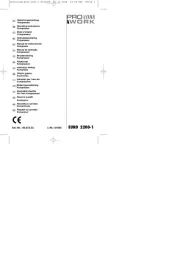
14 September 2025
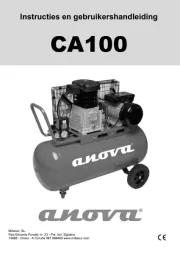
10 September 2025
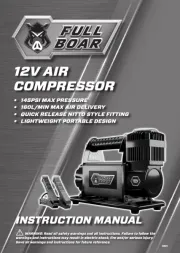
1 September 2025
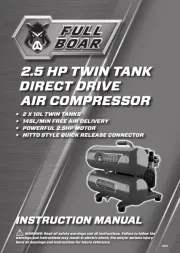
1 September 2025
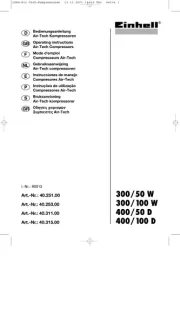
1 September 2025
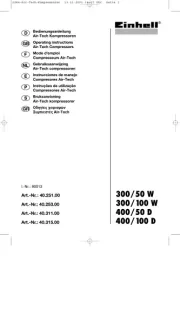
1 September 2025

1 September 2025
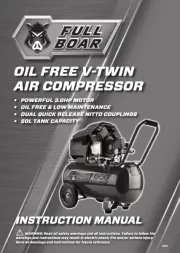
1 September 2025
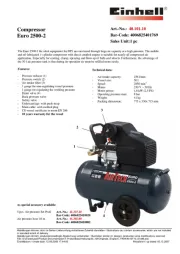
1 September 2025
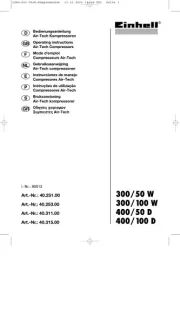
1 September 2025